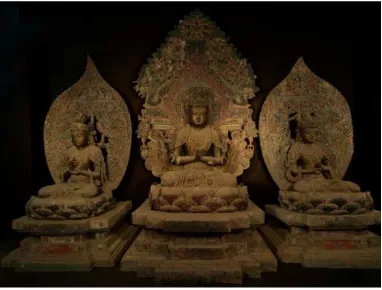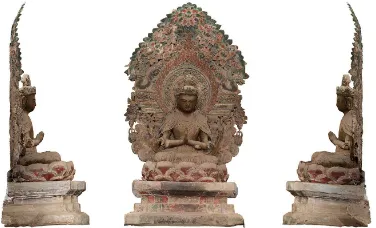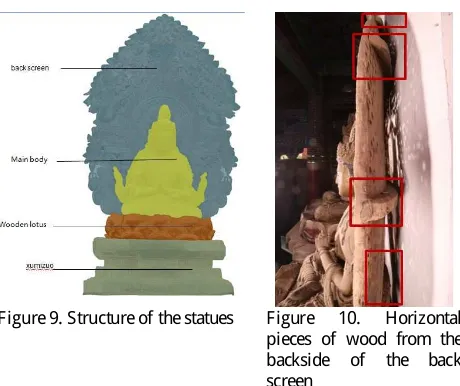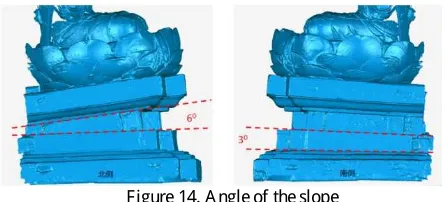A PPL I C A T I O N O F D I G I T A L S UR V E Y M A PPI NG T E C H NO L O G Y I N T H E
I NV E S T I G A T I O N O F C O L O R E D W O O D S T A T UE I N T H E C A O X I T E M PL E
L i Y umin
a
, Z heng Y u
a
a
B eijing G uo W enY an Information T echnology co., L T D ,
B eijing,
C hina
C ommission ⅱ. D igitizing heritage places
K E Y W OR D S : the C aoX i temple, colored wood statues, digital survey mapping technology
A B S T R A C T :
T he colored wood statues in the C aoX i T emple represent the S andashi( Manjushri, S amantabhadra , A valokitesvar) in the
B uddhism.T hese statues with great value were carved in D ali kingdom of the S ong dynasty. B ecause of natural and man-made
reasons, disease has become very seriously both in the painted layer on the surface and the structure inside. S o it is very important to
record the current situation, analyze the structure, craft and material, and detect the cause of disease. T his paper takes the colored
wood statues as the research object, and kinds of digital survey technology were applied in the process. T he R esearch results will
play an important role in the protection, explanation and display.
1. PR OF I L E S OF T H E C A O X I T E M PL E
1.1 G eneral I nstr uctions
T he C ao xi temple which was built in the tang dynasty is
located in A nning of Y unnan province. T he temple was built on
the hill, sitting west to east. T here are shanmen, tianwangdian,
main shrine, houdian located in the central axis. the three
famous color wood statues " Manjushri, S amantabhadra ,
A valokitesvar " which were sculptured in the S ong dynasty
conserved in the main shrine, e.g. F igure 1. T hese three color
wood statues with great values in history, art and science is one
of the most precious cultural relics to the temple.
F igure 1. C olor wood statues in the C aoxi T emple
In this paper, much data information of form, quality, color of
the three color wood statues was obtained precisely by many
survey and mapping methods.
2. I NF OR M A T I ON OB T A I NI NG
2.1 I nfor mation Obtaining
T he three-dimensional scanning technique is used to record the
geometry relationship between the statues, the statues and the
building. T he measuring error of the single point obtained is
less than 2mm, and the data registration error is less than 3mm,
e.g. F igure 2. A fter data processing, the distance of the point
cloud of yard space is between 5~10mm, and the distance of the
point cloud of the inside of the main shrine is between
1.5~3mm, e.g. F igure 3.
F igure 2. Point cloud of the yard
F igure 3. Point cloud of the building
The International Archives of the Photogrammetry, Remote Sensing and Spatial Information Sciences, Volume XLII-2/W5, 2017 26th International CIPA Symposium 2017, 28 August–01 September 2017, Ottawa, Canada
This contribution has been peer-reviewed.
More accurate instrument for data obtaining is used to record
the details of the tiny geometry and disease information of the
color wood statues. T his can be used for monitoring of
development of extend of the disease. T he measuring error of
the single point obtained is less than 0.1mm, and the distance of
the points in point cloud is less than0.3mm, e.g. F igure 4.
F igure 4. 3D modal of the statue
2.2 C olor and T extur e R ecor ding
R ecording the color and texture of the status objectively and
actually. C olor and texture of the high resolution images reflects
the surface disease information, so resolution of the image
obtained must be higher than 75D PI. T hrough these image,
disease on the surface can be precisely located, e.g. F igure 5.
F igure 5. High resolution images of color and texture
2.3 C olor ed L evel A nalysis
S E M-E D S analysis, R aman spectrum analysis, X R F , X R D were
used for obtaining the information on structures, the materials
and the traditional crafts of the colored level of wood statues.
2.4 S uppor t A nalysis
T hrough the X -ray technology, the structure of the wood
statues inside can be detected non-destructively. A nd
furthermore, the repair marks in the history, the traditional
crafts , and the cracks inside of the wood statues can also be
found in the photos.
3. S UR V E Y A ND A NA L Y S I S OF W O OD S T A T UE S
3.1 A nalysis of S peculation of H istor y
T here is a space for storage inside the chest of each wood statue
through X -ray images, e.g. F igure 6. generally speaking, there
should be sutras, jewels and the five cereals. However, T hese
fillers don not exist anymore. T his is probably related to the
history of the temple's early neglected. W e can also find some
components which were made of clay through X -ray images,
such as hands, wrists and forearms, e.g. F igure 7. T his is
probably the method of the beginning of the process, and it is
more likely to be reshaped later, but the exact date of the repair
is uncertain.
F igure 6. S pace in the chest F igure 7. C omponents of
different materials
T hrough analysis of colored level, 2-4 layers are found on the
surface of the wood statues, e.g. F igure 8. T his shows that there
have been at least four major repair or decoration in history.
F igure 8. 4 layers color level
3.2 A nalysis of M aterial, S tr uctur e and C rafts
3.2.1 A nalysis of the S uppor t
1. analysis of structure
T he three wood statues have the same structure, and each of
them is made up of four parts from bottom to top: the
xumizuo, the wooden lotus, the main body and the back screen,
e.g. F igure 9. T he xumizuo which is made up of
pieces of wood has four layers, and these layers are
connected together by the mortise and tenon joints
structure. T he wooden lotus is on the top of xumizuo. T he main
body is on the top of the wooden lotus. T he back screen is
connected with the wooden lotus, and it is is fixed by 3
horizontal pieces of wood from the backside of the back screen ,
e.g. F igure 10.
The International Archives of the Photogrammetry, Remote Sensing and Spatial Information Sciences, Volume XLII-2/W5, 2017 26th International CIPA Symposium 2017, 28 August–01 September 2017, Ottawa, Canada
This contribution has been peer-reviewed.
F igure 9. S tructure of the statues F igure 10. Horizontal
joints structure and the steel J oint C onnector. A nd the headwear
and ribbon which are carved separately are fixed on the main
body by the mortise and tenon joints structure and the steel
J oint C onnector. T hese inner information of wood statues can
be seen clearly from the X -ray images.
F igure 11. W ood grain of the
statues
F igure 12. S teel J oint
C onnectors
T he components ,such as hands, wrists, forearms, most of the
headwear and ribbon, were made of clay through X -ray images.
T he steel J oint C onnectors include not only traditional iron
nails, but also modern iron nails. T his shows that the three
wood statues have been repaired many times, not only in history,
but also in modern times, e.g. F igure 12.
2. analysis of structure
materials should be elm, e.g. F igure 13.
F igure 13. Material of lumber
T he moisture content of the wood determines the expansion or
contraction of the wood, e.g. T able 1. T he moisture content of
the xumizuo is between 11% ~ 15%. T his value is consistent
with the average moisture content (annual mean value: 13.5%,
moisture content range: 9.8%~16.6%) of the K unming area. It
shows that these wood statues which have been put for many
years have been consistent with the local wood equilibrium
moisture content. T hey are already basically stable. However,
because of the hydroscopicity, the moisture content of wood
will change with the change of temperature and humidity in the
environment. A nd the wood will be swell-shrinking further.
D etected
preservation in the semi-open environment, there are many
kinds of diseases in these three wood statues. those diseases can
be divided into support disease and color level disease.
4.1 D isease of the S uppor t
T he disease the support affects the stability and preservation of
the structure of the statue seriously. T here are several diseases
of the statues: deterioration, slope, cracking and incompleteness. The International Archives of the Photogrammetry, Remote Sensing and Spatial Information Sciences, Volume XLII-2/W5, 2017
26th International CIPA Symposium 2017, 28 August–01 September 2017, Ottawa, Canada
This contribution has been peer-reviewed.
F igure 14. A ngle of the slope
F rom outward appearance of the sculpture of S amantabhadra, it
leans to the north. Measurements were made based on the
three-dimensional model. T he sculpture is tilted backwards 6° and
3°from the north and the south respectively, e.g. F igure 14. A nd
inclines to west in an angle of 3, e.g. F igure 15. It is assumed
that the sculpture xumizuo was splitting or rotten at the rear of
the third floor of the north side and the second floor of the south
side of the supporting members, and the north side is much
worse.
F igure15. T he statue
leans toward the
north
F igure 16. C rack in the statue
Measurements were also made based on the three-dimensional
model of the other two statues. T hey all lean to the west, but the
the angle is very small.
C racking is also one of the main diseases of the statues.
T his basically has two reasons: A ging of the fittings
causes cracks in the joints of the components. A nother
reason is that swell-shrinking causes the wood to crack. A 0.7
meters long connected crack from head to abdomen is found
inside of the statue of S amantabhadra through the X -ray images,
e.g. F igure 16.
4.2 D isease of the C olor level
T he disease of color level affects the stability and preservation
of the color level of the statue. T here are several diseases of
these statues: become warped, cracking, shedding, dust, and so
on. A ccording to the statistics, the area of the dust disease is the
largest. T his area covers 68.11% of the superficial area. C olor
lever layer warped and shedding become the most important
and serious, covering 2.57% and19.77% of the superficial area.
5. C ONC L US I O N
B ased on the related documents and on the basis of field
reconnaissance, this paper uses a variety of digital survey and
mapping technology, extracts the cultural relic information
objectively and accurately, and gets important information
applied in the conservation projects for wood statues of C ao
X i temple. A t the same time, exploring the operational and
technical standards. T his result will provide the operating
process and technical standard for other projects in digtal
investigation and mapping of ancient statues.
R E F E R E NC E S
B ai C hengjun, W ang Qiheng., 2013. 3d laser scanning
technology is used in cultural relics and archaeological mapping.
science and technology archaeology. pp. 436-439.
D ing Z hongming, W u L aiming., 2013. T he application of X -ray
photographic technology in the study of cultural relics. C ultural
preservation and archaeological science. pp. 38-46.
Hang J ianrong., 2012. T he C ao X i T emple records.
J in X i, He S hengtan., 1739. A nning state records.
Ma E rni, Z hao Guangjie., 2006. T he dry condensation of the
wood is from the equilibrium state to the non-equilibrium state.
J ournal of B eijing F orestry University. pp. 138-138.
Z hao K un, Y ang D ayu., 2013. T he architectural style of cao xi
temple and its religious culture. A rts C ircle. pp. 93. The International Archives of the Photogrammetry, Remote Sensing and Spatial Information Sciences, Volume XLII-2/W5, 2017
26th International CIPA Symposium 2017, 28 August–01 September 2017, Ottawa, Canada
This contribution has been peer-reviewed.



